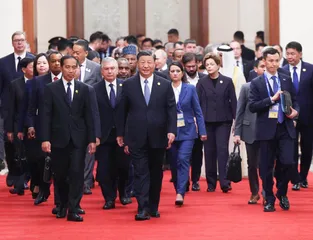A Guiding Beacon for a Perplexed World and A Lasting Power for Improving Quality and Growth
作者: Wang Fan

The world today is entering a new period of turbulence and change, with frequent and overlapping crises. Confrontations in international politics are mainly concentrated in the three major geopolitical sectors. The international landscape is being fractured and reorganized, and some new features and trends are gradually emerging. The formation of “mini-multilateral” clubs has accelerated under the competitive situation, the possibility of a new Cold War in Europe has risen, the United States’ “friendly offshore outsourcing” and supply chain reorganization strategy has led to a trend of fragmentation in the global economy, and the Global South has risen and contributed to the reshaping of the geopolitical landscape. In the face of many uncertainties, risks and challenges in the world today, China has upheld the concept of building a community with a shared future for mankind, put forward innovative global governance programs, promoted major country diplomacy with Chinese characteristics, and created new opportunities and made new contributions to world peace, development and governance through its own development and progress.
The World Has Entered A New Period of Turbulence and Change
I. Crisis: Development and Security Issues Remain Prominent
The international situation in 2023 can be described as a crisis. The energy and food crises have been triggered by local war crisis, and the debt crisis has deepened as a result of the overlapping of multiple crises. The spillover effects of the crisis have been magnified as never before, and the energy, nuclear, food and debt crisis are intertwined, directly jeopardizing the environment and quality of human existence.
On the one hand, the deficit in global security governance has widened, and traditional and non-traditional security threats have become mutually reinforcing. The withdrawal of major powers from international treaties has raised the risk of nuclear proliferation, and the international arms control is facing multiple challenges. In February 2023, Russia announced the suspension of the New Strategic Arms Reduction Treaty (NSART); and in November, Russia and NATO announced the formal withdrawal from and suspension of the Treaty on Conventional Armed Forces in Europe (CFE). U.S.-British-Australian nuclear submarine cooperation exacerbates the risk of global nuclear proliferation and poses a serious impact on global security, especially in the Asia-Pacific region. Disruptive technologies in the fields of outer space, cyber space, biology and artificial intelligence are developing at a rapid pace and are being rapidly applied in international conflicts, and the international community has yet to reach an agreement on the norms governing the use of high and new technologies, so that international strategic stability is facing serious challenges.
On the other hand, under the current severe and complex situation, non-traditional security threats have to some extent been overshadowed by traditional security threats, and have not been fully emphasized by all countries. Global demographic problems are highlighted, and the employment pressure brought by labor force reduction and aging is increasing. International oil and gas prices continue to fluctuate in 2023, and the production capacity of a large number of energy-intensive industries in Europe has plummeted, so the energy crisis has had a worldwide impact. The World Health Organization reports that 675 million people worldwide still lack access to electricity, 2.3 billion people rely on hazardous fuels for cooking, and the world is far from achieving the 2030 Sustainable Development Goals. Global terrorist activities were concentrated in South Asia and sub-Saharan Africa, and terrorist organizations were linked to transnational organized crime groups. Some less developed regions also face a serious food security crisis.
II. Conflicts: Two Local Wars with Far-Reaching Consequences
The Ukraine crisis and the Israeli-Palestinian conflict are the two local wars with the highest intensity and most far-reaching impact in 2023. The Western countries have been increasing their assistance to Ukraine, squeezing Russia’s strategic living space, and launching a “cognitive war” aimed at competing for people’s hearts and minds and shaping people’s worldview. The U.S. uses artificial intelligence technology on the battlefield to anticipate Russian military actions, and while Russia and Ukraine frequently launch large-scale drone strikes. In September 2023, U.S. Assistant Secretary of Defense Marla Carlin noted that Ukraine has become a “laboratory for military technological innovation,” and that technological innovations in the fields of artificial intelligence and drones have been used on the battlefield. The Western countries, led by the United States, continue to send advanced weapons and ammunition to Ukraine, including cluster munitions and depleted uranium munitions, which have caused endless harm. The Ukrainian crisis is characterized by a hybrid war: in addition to the use of high-tech and heavy weapons, the United States and other countries are also using financial sanctions and the Starlink system in the service of this proxy war.
The Israeli-Palestinian conflict is the biggest “black swan” event in the world in 2023. On October 7, 2023, Hamas launched a three-dimensional air, land and sea raid on Israel’s mainland called Al Aqsa Floods. More than 3,000 rockets were fired in less than 24 hours, breaking through Israel’s Iron Dome air defense and intelligence system. The Israeli army suffered the heaviest blow since the Yom Kippur War in 1973. Since then, the Israeli army has launched a large-scale retaliatory military operation against the Palestinians, and the death toll on both sides has exceeded 20,000 people. The likelihood of this conflict escalating into a sixth Middle East war is relatively small, and the possibility of it evolving into a prolonged, low-intensity localized war is higher. Regional hotspot issues have given rise to a highly sensitive period of transition in the international landscape, making coordination among the major countries even more difficult, and the situation in the region will be characterized by great volatility and even long-term turbulence.